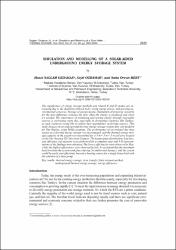| dc.contributor.author | Özdamar, Hazel Sağlam | |
| dc.contributor.author | Özdamar, Seyit | |
| dc.contributor.author | Mert, Suha Orçun | |
| dc.date.accessioned | 2023-12-11T10:12:30Z | |
| dc.date.available | 2023-12-11T10:12:30Z | |
| dc.date.issued | 2023 | en_US |
| dc.identifier.citation | Ozdamar, H.S., Ozdamar, S., Mert, S.O. (2023). Simulation and Modelling of A Solar-Aided Underground Energy Storage System. Thermal Science, 27 (4), pp. 2935-2946.
https://doi.org/10.2298/TSCI220913025S | en_US |
| dc.identifier.issn | 0354-9836 | |
| dc.identifier.uri | https://doi.org/10.2298/TSCI220913025S | |
| dc.identifier.uri | 2334-7163 | |
| dc.identifier.uri | https://hdl.handle.net/20.500.12508/2622 | |
| dc.description.abstract | The significance of energy storage methods and related R and D studies are increasing due to the depletion of fossil fuels, rising energy prices, and growing environmental concerns. Storage of energy means elimination of practical concerns for the time difference between the time when the energy is produced and when it's needed. The importance of producing and storing energy through renewable sources is increasing every day, especially in developing countries like Turkiye, as such countries would like to reduce their dependence on foreign sources. This study focuses on an underground thermal energy storage system that was modeled for Van Region, using M-file program. The performance of an isolated day heat system as a thermal energy storage was investigated, and the thermal energy storage capacity of the system was researched for a 5 m x 5 m x 5 m soil area located on the Van Yuzuncu Yil University Campus. The temperature distribution, heat loss, and efficiency calculations were performed for a complete year and 3-D representations of the findings were obtained. The lowest efficiencies were observed in May, while the highest efficiencies were observed in July. It was found that the maximum heat loss from the system took place during December and January, and the system could be easily and effectively become a heating source for a single household with the addition of a heat pump. | en_US |
| dc.language.iso | eng | en_US |
| dc.publisher | Serbian Society of Heat Transfer Engineers | en_US |
| dc.relation.isversionof | 10.2298/TSCI220913025S | en_US |
| dc.rights | info:eu-repo/semantics/openAccess | en_US |
| dc.subject | Energy efficiency | en_US |
| dc.subject | Finite element method | en_US |
| dc.subject | Heat transfer | en_US |
| dc.subject | Thermal energy storage | en_US |
| dc.subject | Underground thermal energy storage | en_US |
| dc.subject.classification | Thermodynamics | |
| dc.subject.classification | Air Source Heat Pumps | |
| dc.subject.classification | Solar | |
| dc.subject.classification | Solar Heating | |
| dc.subject.other | Developing countries | |
| dc.subject.other | Energy efficiency | |
| dc.subject.other | Fossil fuels | |
| dc.subject.other | Fuel storage | |
| dc.subject.other | Heat losses | |
| dc.subject.other | Heat storage | |
| dc.subject.other | Thermal energy | |
| dc.subject.other | Energy | |
| dc.subject.other | Energy prices | |
| dc.subject.other | Environmental concerns | |
| dc.subject.other | Simulation and modeling | |
| dc.subject.other | Storage systems | |
| dc.subject.other | Thermal energy storage | |
| dc.subject.other | Time-differences | |
| dc.subject.other | Underground energy storages | |
| dc.subject.other | Underground thermal energy storage | |
| dc.subject.other | Finite element method | |
| dc.title | Simulation and Modelling of A Solar-Aided Underground Energy Storage System | en_US |
| dc.type | article | en_US |
| dc.relation.journal | Thermal Science | en_US |
| dc.contributor.department | Mühendislik ve Doğa Bilimleri Fakültesi -- Petrol ve Doğalgaz Mühendisliği Bölümü | en_US |
| dc.identifier.volume | 27 | en_US |
| dc.identifier.issue | 4 | en_US |
| dc.identifier.startpage | 2935 | en_US |
| dc.identifier.endpage | 2946 | en_US |
| dc.relation.publicationcategory | Makale - Uluslararası Hakemli Dergi - Kurum Öğretim Elemanı | en_US |
| dc.contributor.isteauthor | Mert, Suha Orçun | |
| dc.relation.index | Web of Science - Scopus | en_US |
| dc.relation.index | Web of Science Core Collection - Science Citation Index Expanded | |
















